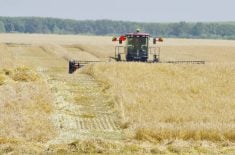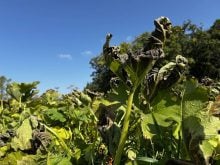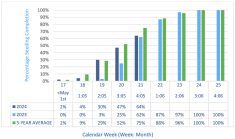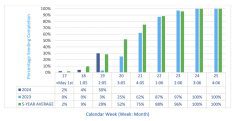Southwest Region
Cloudy, cool, rainy conditions with high humidity prevailed for the week, but cleared on the weekend to allow for marginal harvest progress. Rainfall accumulation was low with 2 to 10 mm received for the week providing some topsoil and sub soil moisture recharge. Daytime temperatures hovered in the single digit above zero to low teens. Nighttime temperatures were near the freezing point to -8C Thursday morning.
Harvest in general is 75 per cent complete, but there are still some areas close to Highway 16 (Binscarth, Shoal Lake, Oakburn, Newdale, Straithclair) and North of Highway 45 which have 60-70 per cent harvest left, including cereals and canola.
Read Also

What is perfect Christmas weather?
What is ‘perfect’ Christmas weather on the Prairies? Here’s where you should head this holiday, according to historical weather data.
Soybeans, flax and some straight cut canola coming off. Soybeans yielding 25 to 40 bu/ac. Soybeans and corn represent the majority of acres left to harvest.
Grain corn and sunflower experiences several hard frosts, plants are drying down now. No reports of any harvest yet. Silaging of corn is going on. With the hard frost received this week, this will terminate green plant tissue and help with drying down.
Winter cereals emerged 1-2 leaf. Slow progress with cold weather.
Even though rain has occurred, in the driest areas, it is not enough to replenish low dugouts and sloughs. The wet cool weather has slowed progress on corn and green feed silages and any thought of taking a cutting second cut hay where available.
Livestock are mostly off pasture with some being fed on pasture. More straw has been dropped for baling. Calls regarding winter water and feed have decreased as producers are putting plans in place. Dugouts 45 per cent full.
Northwest Region
Harvest took place throughout the region in between intermittent localized rain and snow showers, with operations underway again over the weekend. Cool temperatures with frost and heavy dew have also impacted harvest completion. Daytime temperatures were down into the low teens with nighttime temperatures dropping well below zero throughout the entire region. Rainfall accumulations resulted in an average of 13 mm through most parts of the region. The crop in the region is estimated at 75 per cent harvested with operations on the east side more complete, while the northern part of the region still has a larger percent of acres remaining to harvest.
Spring wheat reported as 90 to 95 per cent combined throughout the region, with some later seeded fields still standing. Yields ranging from 65 to 85bu/ac. Fieldwork is being completed as conditions allow.
The recent damp and wet weather has been a challenge for producers trying to combine their canola crop. Much of the canola harvested this past week came off tough or damp and needs to be dried for storage. Around Swan River the canola harvest is about 45 to 50 per cent complete, yields of 45 to 60 bu/ac; canola harvest in Roblin area 40 per cent complete; canola harvest underway at The Pas at 10 to 15 per cent complete.
Lentil and pea harvests are complete with yields of 45 to 50 bu/ac and 50 to 70 bu/ac respectively. Harvest of soybeans is underway in the Northwest Region with reported yields of 35 bu/ac.
Damp conditions and cloudy weather has made it challenging for producers still baling feed and straw. Corn silage harvest is still on going. With the hard killing frost on the weekend all vegetation growth has subsided, thus livestock still on pasture require supplementation. Fall predation damage to domestic livestock and late season crops has begun, as crop options have diminished with harvest.
Central Region
Another week of cool, cloudy, rainy conditions resulting in marginal harvest progress. Precipitation was low and came mostly as light drizzle. Only 5 to 10 mm accumulated during the week. Surface soil moisture conditions are rated as good. Daytime temperatures remained below normal hovering in the single digit to mid teens. Nighttime temperatures were cold with a couple of hard frost down to -5C in many locations.
Planted winter cereals are growing slowly with the cold temperatures. The earliest planted fields have up to three leaves.
Cereals harvest is considered done as well as most of the canola. Remaining canola fields harvested, coming off tough to dry, but have good seed quality.
Flax is ripe with harvest 60 to 70 per cent complete with yields reported as 30 to 45 bu/ac. Sunflowers harvest has begun with <5 per cent acres combined. Desiccated fields being combined dry to tough for moisture, good seed quality, good test weight and excellent yields.
Corn harvest progressed slightly over the weekend, with reported yields of 80 to 120 bu/ac, with harvested grain moisture of 16 to 25 per cent range depending on how dry conditions were leading into harvest. The frost should help kill remaining green tissue and help with dry down.
Soybeans harvest 65 to 75 per cent complete with yields of 25 to 40 bu/ac. Later maturing and harvested fields yielding better that earlier ones. Growers are hoping for a break in the weather to finish the harvest.
No significant harvest progress made on edible beans which is about 80 per cent completed. Field peas harvest done; yields 30 to 80 bu/ac and good quality.
Post harvest tillage progressed with the favourable top soil moisture conditions. Soil sampling continues ahead of the fall fertilization period. Manure application continues.
Potato harvest continues with good yield reports in the 300-350 cwt per acre.
Recent rains helped green up pastures, but growth is stopped as temperatures cool. Many producers have been supplementing hay in pastures and it is expected that cattle are to come off pasture soon for the winter feeding period. More than usual feed sampling and testing is being done. Livestock producers are sourcing alternative feed sources to meet their needs.
Livestock water supply is poor and holding with water levels in the 25 to 35 per cent range in dugouts with poorer water quality.
Eastern Region
Rainfall accumulation continued to vary across region this week from 6 mm to 18 mm. Soil moisture conditions on crop land were rated as about 80 per cent surplus and 20 per cent adequate in northern districts. Central districts are rated 50 per cent surplus and 50 per cent adequate. In southern districts, soil moisture conditions on crop land were rated as 10 per cent adequate, 60 per cent short and 30 per cent very short. Weather for the week up until Friday was cool and cloudy with below normal temperatures and intermittent drizzle to light rain.
While it remained cold and got colder than normal over the weekend, skies cleared and the sun shone allowing some progress on soybean harvest. Overnight frosts occurred during the week with the hardest frost occurring Sunday night and into Monday morning. Coldest temperatures were -4C to -5C with below 0C periods lasting for as long as 10 hours in some locations.
Frost is of relatively little concern to growers now given the maturity stage of the crops remaining. Some concern about potential for pod shatter in the soybeans going forward if the weather does not improve because of the wetting and drying cycles occurring, but not a problem so far.
Harvest progress in the Eastern region is estimated at 75 per cent complete. Cereal harvest is complete. Yields and quality were both very good this year. Spring Wheat yields range from 50 to 80bu/ac. Reports indicated good quality and protein levels ranging from 13 per cent to 16 per cent. Oat acres reported yields from 80 to 130bu/ac.
Canola harvest mostly wrapped with an estimated 99 per cent of acres combined with yields ranging from 35 to 60bu/ac with good quality.
Late soybeans R8 and drying down. Soybean harvest estimated at 60 per cent complete as an average for the region (Northern districts are at 25 per cent complete while Central and Southern districts are at 90 per cent complete). Harvest is on-going with yield reports in the 30 to 50 bu/ac range. Growers were able to get out on some soybean fields on Saturday and to a greater degree on Sunday and bring in some beans. Seed moistures were as low as 15 per cent but ranged higher. Producers had to be selective as to what fields they went into to avoid mud and ruts. Green soybean seed issues still have not show up as a significant concern for the crop being harvested in the northern districts.
Sunflowers are all at the R9 stage and are ready to harvest, weather dependent. Corn harvest is on-going and estimated at 20 per cent complete with yields reported as 100 to 140bu/ac, but variable depending on the summer rainfall. Producers are taking corn off at wet moisture to avoid yield loss due to weak stocks and previous lodging that occurred due to high winds.
Hay and pasture land moisture conditions were rated as 70 per cent short and 30 per cent very short. Pasture land conditions were rated as 30 per cent fair, 40 per cent poor and 30 per cent very poor. Producers are weaning calves and feeding livestock on pasture as well as putting cows on hay fields.
Some grain corn is getting cut for silage. Some producers are cutting second cut grass that was fertilized with hog manure.
Winter feed supplies of hay are rated at 50 per cent adequate and 50 per cent inadequate, straw is rated at 40 per cent adequate and 60 per cent inadequate. Greenfeed is rated as 100 per cent adequate with the feed grain supply rate at 80 per cent adequate and 20 per cent inadequate.
The availability of livestock water is rated at 80 per cent adequate and 20 per cent inadequate. Dugouts have about 20 per cent of the water capacity with some dugouts dry
Interlake Region
Frosts and rainfall amounts from 5-19 mm have hampered harvest progress this past week. All of the crop combined this weeks has to be either aerated or dried or both, to keep grain in condition for storage and reduce spoilage.
Yields throughout the Interlake vary dramatically due to seasonal precipitation variability; rainfall since May 1 at Moosehorn totals 184 mm or 55 per cent of normal, whereas at Stonewall 380 mm or 115 per cent of normal.
Cereal harvest is 99 per cent complete with a wide range of yields.
Canola and soybean harvest progressed modestly and 3 to 5 per cent since last week. Canola harvest is now 95 per cent complete. Soybean harvest varies from 15 to 65 per cent complete; yields from 15-50 bu/ac.
Grain buyers reporting less soybean samples coming in with high green seed content recently; a few samples showing signs of hail damage.
Fall rye continues to be seeded with acres higher than in recent past.
Little or no combining of sunflowers so far; grain corn about 10 to 15 per cent done.
Seed alfalfa yields typically range from 150-350 lbs/acre. Most seed alfalfa fields desiccated now and awaiting drier weather to be combined.
Phosphorus, potash and sulphur fertilizers are being applied; more so on fields intended for soybeans or canola next year. Little nitrogen fertilization so far. Soil testing and some land work continues.
Cattle being turned out onto hay fields since recent frosts, also supplemental feeding on pasture occurring.
Tame haying mostly complete. Native haying is shut down, and may start up again if weather permits.
Early weaning and pregnancy checking occurring in livestock due to feed/pasture shortage and low dugout levels.














